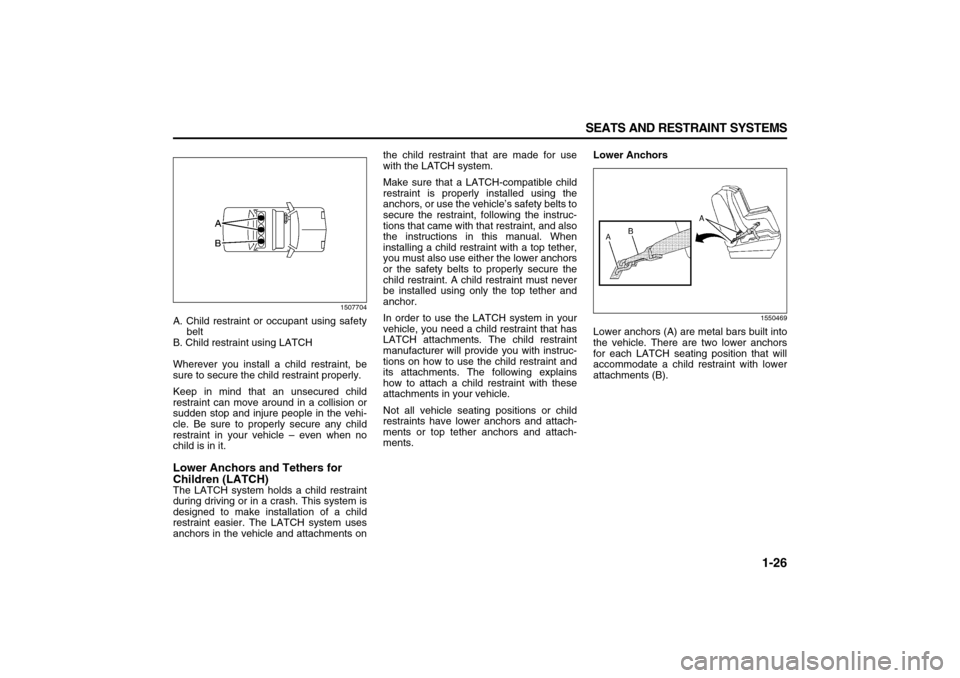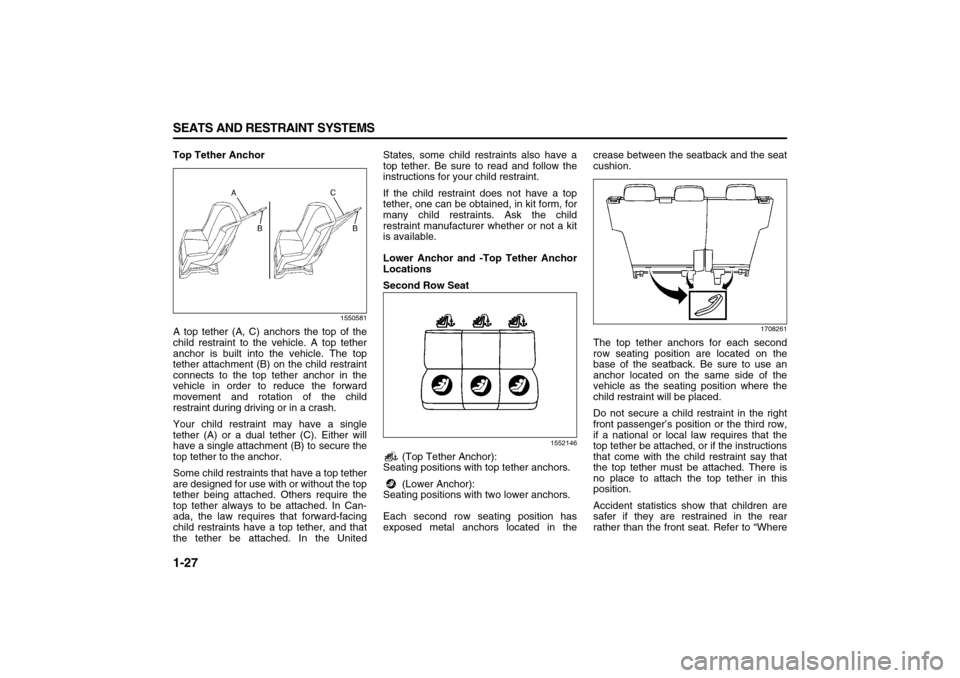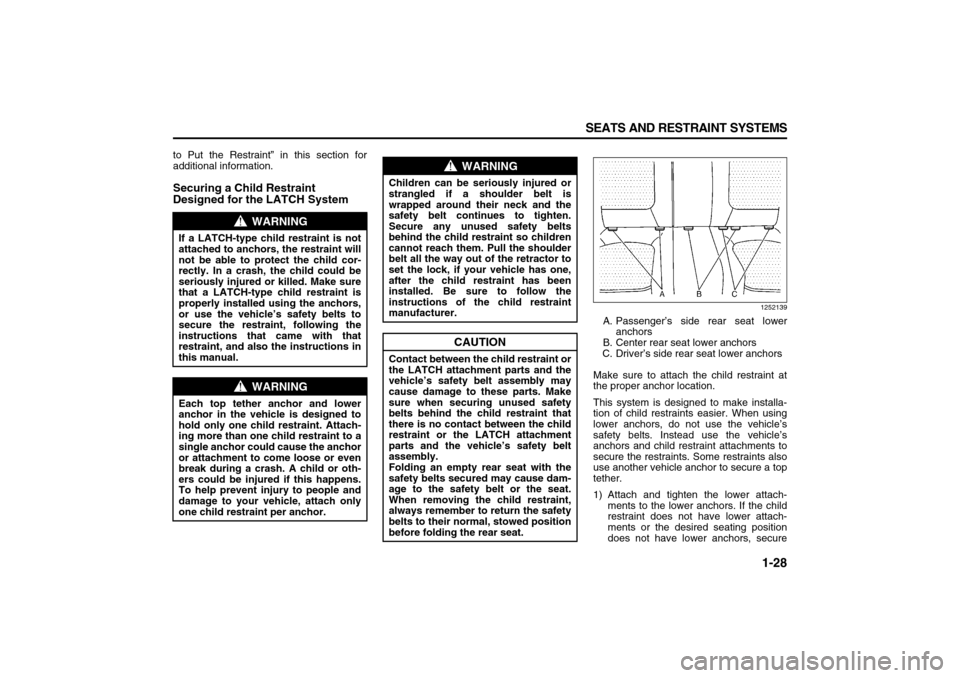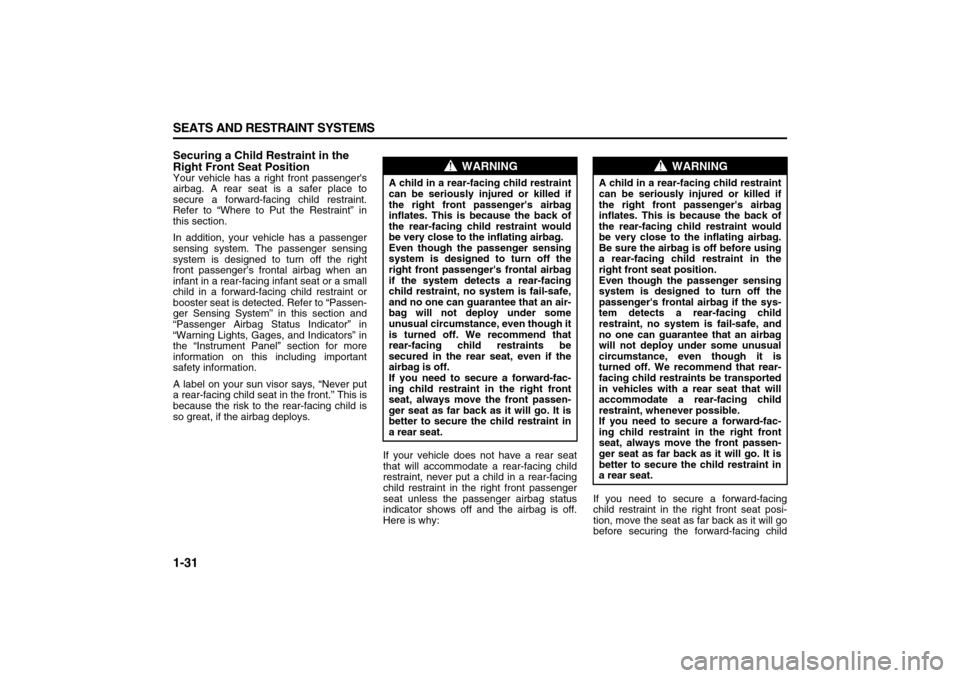2007 SUZUKI XL7 ECU
[x] Cancel search: ECUPage 38 of 274

1-26 SEATS AND RESTRAINT SYSTEMS
78J00-03E
1507704
A. Child restraint or occupant using safety
belt
B. Child restraint using LATCH
Wherever you install a child restraint, be
sure to secure the child restraint properly.
Keep in mind that an unsecured child
restraint can move around in a collision or
sudden stop and injure people in the vehi-
cle. Be sure to properly secure any child
restraint in your vehicle – even when no
child is in it.Lower Anchors and Tethers for
Children (LATCH)The LATCH system holds a child restraint
during driving or in a crash. This system is
designed to make installation of a child
restraint easier. The LATCH system uses
anchors in the vehicle and attachments onthe child restraint that are made for use
with the LATCH system.
Make sure that a LATCH-compatible child
restraint is properly installed using the
anchors, or use the vehicle’s safety belts to
secure the restraint, following the instruc-
tions that came with that restraint, and also
the instructions in this manual. When
installing a child restraint with a top tether,
you must also use either the lower anchors
or the safety belts to properly secure the
child restraint. A child restraint must never
be installed using only the top tether and
anchor.
In order to use the LATCH system in your
vehicle, you need a child restraint that has
LATCH attachments. The child restraint
manufacturer will provide you with instruc-
tions on how to use the child restraint and
its attachments. The following explains
how to attach a child restraint with these
attachments in your vehicle.
Not all vehicle seating positions or child
restraints have lower anchors and attach-
ments or top tether anchors and attach-
ments.Lower Anchors
1550469
Lower anchors (A) are metal bars built into
the vehicle. There are two lower anchors
for each LATCH seating position that will
accommodate a child restraint with lower
attachments (B).
Page 39 of 274

1-27 SEATS AND RESTRAINT SYSTEMS
78J00-03E
Top Tether Anchor
1550581
A top tether (A, C) anchors the top of the
child restraint to the vehicle. A top tether
anchor is built into the vehicle. The top
tether attachment (B) on the child restraint
connects to the top tether anchor in the
vehicle in order to reduce the forward
movement and rotation of the child
restraint during driving or in a crash.
Your child restraint may have a single
tether (A) or a dual tether (C). Either will
have a single attachment (B) to secure the
top tether to the anchor.
Some child restraints that have a top tether
are designed for use with or without the top
tether being attached. Others require the
top tether always to be attached. In Can-
ada, the law requires that forward-facing
child restraints have a top tether, and that
the tether be attached. In the UnitedStates, some child restraints also have a
top tether. Be sure to read and follow the
instructions for your child restraint.
If the child restraint does not have a top
tether, one can be obtained, in kit form, for
many child restraints. Ask the child
restraint manufacturer whether or not a kit
is available.
Lower Anchor and -Top Tether Anchor
Locations
Second Row Seat
1552146
(Top Tether Anchor):
Seating positions with top tether anchors.
(Lower Anchor):
Seating positions with two lower anchors.
Each second row seating position has
exposed metal anchors located in thecrease between the seatback and the seat
cushion.
1708261
The top tether anchors for each second
row seating position are located on the
base of the seatback. Be sure to use an
anchor located on the same side of the
vehicle as the seating position where the
child restraint will be placed.
Do not secure a child restraint in the right
front passenger’s position or the third row,
if a national or local law requires that the
top tether be attached, or if the instructions
that come with the child restraint say that
the top tether must be attached. There is
no place to attach the top tether in this
position.
Accident statistics show that children are
safer if they are restrained in the rear
rather than the front seat. Refer to “Where
Page 40 of 274

1-28 SEATS AND RESTRAINT SYSTEMS
78J00-03E
to Put the Restraint” in this section for
additional information.Securing a Child Restraint
Designed for the LATCH System
1252139
A. Passenger’s side rear seat lower
anchors
B. Center rear seat lower anchors
C. Driver’s side rear seat lower anchors
Make sure to attach the child restraint at
the proper anchor location.
This system is designed to make installa-
tion of child restraints easier. When using
lower anchors, do not use the vehicle’s
safety belts. Instead use the vehicle’s
anchors and child restraint attachments to
secure the restraints. Some restraints also
use another vehicle anchor to secure a top
tether.
1) Attach and tighten the lower attach-
ments to the lower anchors. If the child
restraint does not have lower attach-
ments or the desired seating position
does not have lower anchors, secure
WARNING
If a LATCH-type child restraint is not
attached to anchors, the restraint will
not be able to protect the child cor-
rectly. In a crash, the child could be
seriously injured or killed. Make sure
that a LATCH-type child restraint is
properly installed using the anchors,
or use the vehicle’s safety belts to
secure the restraint, following the
instructions that came with that
restraint, and also the instructions in
this manual.
WARNING
Each top tether anchor and lower
anchor in the vehicle is designed to
hold only one child restraint. Attach-
ing more than one child restraint to a
single anchor could cause the anchor
or attachment to come loose or even
break during a crash. A child or oth-
ers could be injured if this happens.
To help prevent injury to people and
damage to your vehicle, attach only
one child restraint per anchor.
WARNING
Children can be seriously injured or
strangled if a shoulder belt is
wrapped around their neck and the
safety belt continues to tighten.
Secure any unused safety belts
behind the child restraint so children
cannot reach them. Pull the shoulder
belt all the way out of the retractor to
set the lock, if your vehicle has one,
after the child restraint has been
installed. Be sure to follow the
instructions of the child restraint
manufacturer.
CAUTION
Contact between the child restraint or
the LATCH attachment parts and the
vehicle’s safety belt assembly may
cause damage to these parts. Make
sure when securing unused safety
belts behind the child restraint that
there is no contact between the child
restraint or the LATCH attachment
parts and the vehicle’s safety belt
assembly.
Folding an empty rear seat with the
safety belts secured may cause dam-
age to the safety belt or the seat.
When removing the child restraint,
always remember to return the safety
belts to their normal, stowed position
before folding the rear seat.
Page 41 of 274

1-29 SEATS AND RESTRAINT SYSTEMS
78J00-03E
the child restraint with the top tether
and the safety belts. Refer to your child
restraint manufacturer instructions and
the instructions in this manual.
1. Find the lower anchors for the
desired seating position.
2. Put the child restraint on the seat.
3. Attach and tighten the lower attach-
ments on the child restraint to the
lower anchors.
2) If the child restraint manufacturer rec-
ommends that the top tether be
attached, attach and tighten the top
tether to the top tether anchor, if your
vehicle has one. Refer to the child
restraint instructions and the following
steps:
1. Find the top tether anchor.
2. Route, attach and tighten the top
tether according to your child
restraint instructions and the follow-
ing instructions:
1549926
If the position you are using has an adjust-
able head restraint and you are using a
dual tether, route the tether around the
head restraint.
1549824
If the position you are using has an adjust-
able head restraint and you are using a
single tether, raise the head restraint and
route the tether under the head restraint
and in between the head restraint posts.
3) Push and pull the child restraint in dif-
ferent directions to be sure it is secure.Securing a Child Restraint in a Rear
Seat PositionThere is limited space in the third row rear
seating area. If you want to secure a child
restraint in a rear seating position in the
third row, be sure to study the instructions
that came with your child restraint to see if
there is enough room to secure your seat
properly. If the length of the seat cushion is
too short for your child restraint and you
cannot install it in accordance with the
child restraint manufacturers instructions,
secure it in the second row.
If your child restraint has the LATCH sys-
tem, refer to “Lower Anchors and Tethers
for Children (LATCH)” in this section.There are no top tether anchors in the third
row seating positions. Do not secure a
child restraint in the third row if a national
or local law requires that a top tether be
anchored or if the instructions that come
with the restraint say that the top tether
must be anchored.
If your child restraint does not have the
LATCH system, you will be using the lap-
shoulder belt to secure the child restraint in
this position. Be sure to follow the instruc-
tions that came with the child restraint.
Secure the child in the child restraint when
and as the instructions say.
If you are using a rear-facing child restraint
in the second row center position, install
the armrest retention strap.
1) Put the child restraint on the seat.
2) Pick up the latch plate, and run the lap
and shoulder portions of the vehicle’s
safety belt through or around the
restraint. The child restraint instructions
will show you how.
Page 42 of 274

1-30 SEATS AND RESTRAINT SYSTEMS
78J00-03E
1379321
3) Buckle the belt. Make sure the release
button is positioned so you would be
able to unbuckle the safety belt quickly
if you ever had to.
1379324
4) Pull the rest of the shoulder belt all the
way out of the retractor to set the lock.
1379355
5) To tighten the belt, push down on the
child restraint, pull the shoulder portion
of the belt to tighten the lap portion ofthe belt, and feed the shoulder belt
back into the retractor. If you are using
a forward-facing child restraint, you
may find it helpful to use your knee to
push down on the child restraint as you
tighten the belt.
6) If your child restraint has a top tether,
and the position that you are using has
a top tether anchor, attach and tighten
the top tether to the top tether anchor.
Refer to the instructions that came with
the child restraint and to “Lower
Anchors and Tethers for Children
(LATCH)” in this section.
7) Push and pull the child restraint in dif-
ferent directions to be sure it is secure.
To remove the child restraint, just unbuckle
the vehicle's safety belt and let it go back
all the way. The safety belt will move freely
again and be ready to work for an adult or
larger child passenger.
Page 43 of 274

1-31 SEATS AND RESTRAINT SYSTEMS
78J00-03E
Securing a Child Restraint in the
Right Front Seat PositionYour vehicle has a right front passenger's
airbag. A rear seat is a safer place to
secure a forward-facing child restraint.
Refer to “Where to Put the Restraint” in
this section.
In addition, your vehicle has a passenger
sensing system. The passenger sensing
system is designed to turn off the right
front passenger’s frontal airbag when an
infant in a rear-facing infant seat or a small
child in a forward-facing child restraint or
booster seat is detected. Refer to “Passen-
ger Sensing System” in this section and
“Passenger Airbag Status Indicator” in
“Warning Lights, Gages, and Indicators” in
the “Instrument Panel” section for more
information on this including important
safety information.
A label on your sun visor says, “Never put
a rear-facing child seat in the front.” This is
because the risk to the rear-facing child is
so great, if the airbag deploys.
If your vehicle does not have a rear seat
that will accommodate a rear-facing child
restraint, never put a child in a rear-facing
child restraint in the right front passenger
seat unless the passenger airbag status
indicator shows off and the airbag is off.
Here is why:If you need to secure a forward-facing
child restraint in the right front seat posi-
tion, move the seat as far back as it will go
before securing the forward-facing child
WARNING
A child in a rear-facing child restraint
can be seriously injured or killed if
the right front passenger's airbag
inflates. This is because the back of
the rear-facing child restraint would
be very close to the inflating airbag.
Even though the passenger sensing
system is designed to turn off the
right front passenger's frontal airbag
if the system detects a rear-facing
child restraint, no system is fail-safe,
and no one can guarantee that an air-
bag will not deploy under some
unusual circumstance, even though it
is turned off. We recommend that
rear-facing child restraints be
secured in the rear seat, even if the
airbag is off.
If you need to secure a forward-fac-
ing child restraint in the right front
seat, always move the front passen-
ger seat as far back as it will go. It is
better to secure the child restraint in
a rear seat.
WARNING
A child in a rear-facing child restraint
can be seriously injured or killed if
the right front passenger's airbag
inflates. This is because the back of
the rear-facing child restraint would
be very close to the inflating airbag.
Be sure the airbag is off before using
a rear-facing child restraint in the
right front seat position.
Even though the passenger sensing
system is designed to turn off the
passenger's frontal airbag if the sys-
tem detects a rear-facing child
restraint, no system is fail-safe, and
no one can guarantee that an airbag
will not deploy under some unusual
circumstance, even though it is
turned off. We recommend that rear-
facing child restraints be transported
in vehicles with a rear seat that will
accommodate a rear-facing child
restraint, whenever possible.
If you need to secure a forward-fac-
ing child restraint in the right front
seat, always move the front passen-
ger seat as far back as it will go. It is
better to secure the child restraint in
a rear seat.
Page 44 of 274

1-32 SEATS AND RESTRAINT SYSTEMS
78J00-03E
restraint. Refer to “Manual Seats” in this
section.
If your child restraint has the LATCH sys-
tem, refer to “Lower Anchors and Tethers
for Children (LATCH)” in this section.
There is no top tether anchor at the right
front seating position. Do not secure a
child seat in this position if a national or
local law requires that the top tether be
anchored or if the instructions that come
with the child restraint say that the top
tether must be anchored. Refer to “Lower
Anchors and Tethers for Children
(LATCH)” in this section if the child
restraint has a top tether.
You will be using the lap-shoulder belt to
secure the child restraint in this position.
Be sure to follow the instructions that came
with the child restraint. Secure the child in
the child restraint when and as the instruc-
tions say.
1) Your vehicle has a right front passen-
ger’s frontal airbag. Refer to “Passen-
ger Sensing System” in this section. We
recommend that rear-facing child
restraints be secured in a rear seat,
even if the airbag is off. If your child
restraint is for ward-facing, move the
seat as far back as it will go before
securing the child restraint in this seat.
Refer to “Manual Seats” in this section.
When the passenger sensing system
has turned off the right front passen-ger’s frontal airbag, the off indicator in
the passenger airbag status indicator
should light and stay lit when you turn
the ignition to RUN or START. Refer to
“Passenger Airbag Status Indicator” in
“Warning Lights, Gages, and Indica-
tors” in the “Instrument Panel” section.
2) Put the child restraint on the seat.
3) Pick up the latch plate, and run the lap
and shoulder portions of the vehicle’s
safety belt through or around the
restraint. The child restraint instructions
will show you how.
1379321
4) Buckle the belt. Make sure the release
button is positioned so you would be
able to unbuckle the safety belt quickly
if you ever had to.
1379324
5) Pull the rest of the shoulder belt all the
way out of the retractor to set the lock.
1379355
6) To tighten the belt, push down on the
child restraint, pull the shoulder portion
of the belt to tighten the lap portion of
Page 45 of 274

1-33 SEATS AND RESTRAINT SYSTEMS
78J00-03E
the belt, and feed the shoulder belt
back into the retractor. If you are using
a forward-facing child restraint, you
may find it helpful to use your knee to
push down on the child restraint as you
tighten the belt. You should not be able
to pull more of the belt from the retrac-
tor once the lock has been set.
7) Push and pull the child restraint in dif-
ferent directions to be sure it is secure.
8) If the airbag is off, the off indicator on
the instrument panel will be lit and stay
lit when the key is turned to RUN or
START.
If a child restraint has been installed and
the on indicator is lit, turn the vehicle off.
Remove the child restraint from the vehicle
and reinstall the child restraint.
If, after reinstalling the child restraint and
restarting the vehicle, the on indicator is
still lit, check to make sure that the vehi-
cle’s seatback is not pressing the child
restraint into the seat cushion. If this hap-
pens, slightly recline the vehicle’s seatback
and adjust the seat cushion if possible.
Also make sure the child restraint is not
trapped under the vehicle head restraint. If
this happens, adjust the head restraint.
If the on indicator is still lit, secure the child
in the child restraint in a rear seat position
in the vehicle if one is available and check
with your dealer.To remove the child restraint, if the top
tether is attached to the top tether anchor,
disconnect it. Unbuckle the vehicle’s safety
belt and let it go back all the way. The
safety belt will move freely again and be
ready to work for an adult or larger child
passenger.
Airbag SystemYour vehicle has a frontal airbag for the
driver and a frontal airbag for the right front
passenger. Your vehicle also has roof-
mounted rollover airbags designed for
either side impact or rollover deployment.
Roof-mounted rollover airbags are avail-
able for the driver and the passenger
seated directly behind the driver and for
the right front passenger and the passen-
ger seated directly behind that passenger.
For roof-mounted rollover airbags, the
word AIRBAG will appear along the head-
liner or trim.
Also, if your vehicle has a third row pas-
senger seat, your vehicle will have third
row roof-mounted rollover airbags.
Airbags are designed to supplement the
protection provided by safety belts. Even
though today’s airbags are also designed
to help reduce the risk of injury from the
force of an inflating bag, all airbags must
inflate very quickly to do their job.
Here are the most important things to
know about the airbag system: